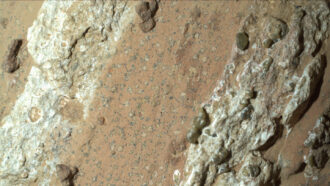Stony bacteria
Lake-dwelling bacterium has hard lumps inside it
By Roberta Kwok

Scientists have discovered a new type of bacterium with a very unusual surprise inside. Within each single-celled microbe are little, hard lumps similar to the bones inside our bodies. These tiny stones make the microbes heavier, perhaps so that the bacteria can sink to the lake floor communities in which they like to live.
Researchers collected the new species, named Candidatus Gloeomargarita lithophora, from a lake in Central Mexico and then grew the bacteria in a lab aquarium. When the scientists peered at the bacteria under a microscope, they saw the rod-shaped organisms had little pearl-like spheres inside. They resembled peas crowded in a pod. “That’s when we figured out that there was something special,” team member Karim Benzerara told Science News. Benzerara works at the CNRS Institute of Mineralogy and Physics of Condensed Matter in Paris.
The researchers analyzed the unexpected lumps and found that each was made of mineral composed of a group of chemicals, including calcium, magnesium, strontium and barium. (A mineral is a solid substance with a specific set of ingredients that is formed by natural processes.)
The aquarium’s water also contained these chemicals. But the proportions of these chemicals in the water differed from those in the lumps. The scientists think that the bacteria might mine specific amounts of each from the water to build their stones. The microbes appear to collect these chemical ingredients in the same way that a person retrieves precise quantities of ingredients from the pantry to make a recipe at home.
It takes energy to make each microscopic stone. So what’s in it for the bacteria? Benzerara’s team suspects the lumps serve like microscopic weights, helping the bacteria to sink deeply. There the bacteria may become part of a biofilm, a gooey community of different types of microbes that essentially glues itself to some rock or other surface. Living in a biofilm — instead of as individual bacteria in the water — is one way microbes protect themselves from stressful elements (such as poisons) in their environment.
The newly discovered species belongs to a group of bacteria called cyanobacteria. Cyanobacteria have existed for 2.7 billion years, and they are part of the reason that people can live on Earth today. Long ago, these little organisms released a lot of oxygen. This made the air easier to breathe and helped other life forms emerge.
Many cyanobacteria make mineral structures on their surfaces. The species Benzerara’s team found is the first known to build minerals inside its cells.
The newfound species could help explain a mystery. Scientists have found preserved, or fossilized, remains of cyanobacteria. Many of the fossils show signs of surface mineral structures. But scientists haven’t found clear evidence of the minerals in fossils older than 1.2 billion years.
Benzerara and his colleagues now wonder if ancient cyanobacteria instead made internal stones. If those minerals proved hard to preserve over time, that might explain why scientists never clearly observed them in especially ancient cyanobacteria fossils.
Power Words
mineral A solid substance with a specific set of chemical ingredients that is formed by natural processes.
bacterium A single-celled organism. Bacteria lack some of the cell organization seen in other types of cells.
cyanobacterium A type of bacterium that can convert carbon dioxide into other molecules, including oxygen.
proportion The amount of a certain component of a mixture relative to other components. For example, if a bag contains 2 apples and 3 oranges, the proportion of apples to oranges in the bag is 2 to 3.







